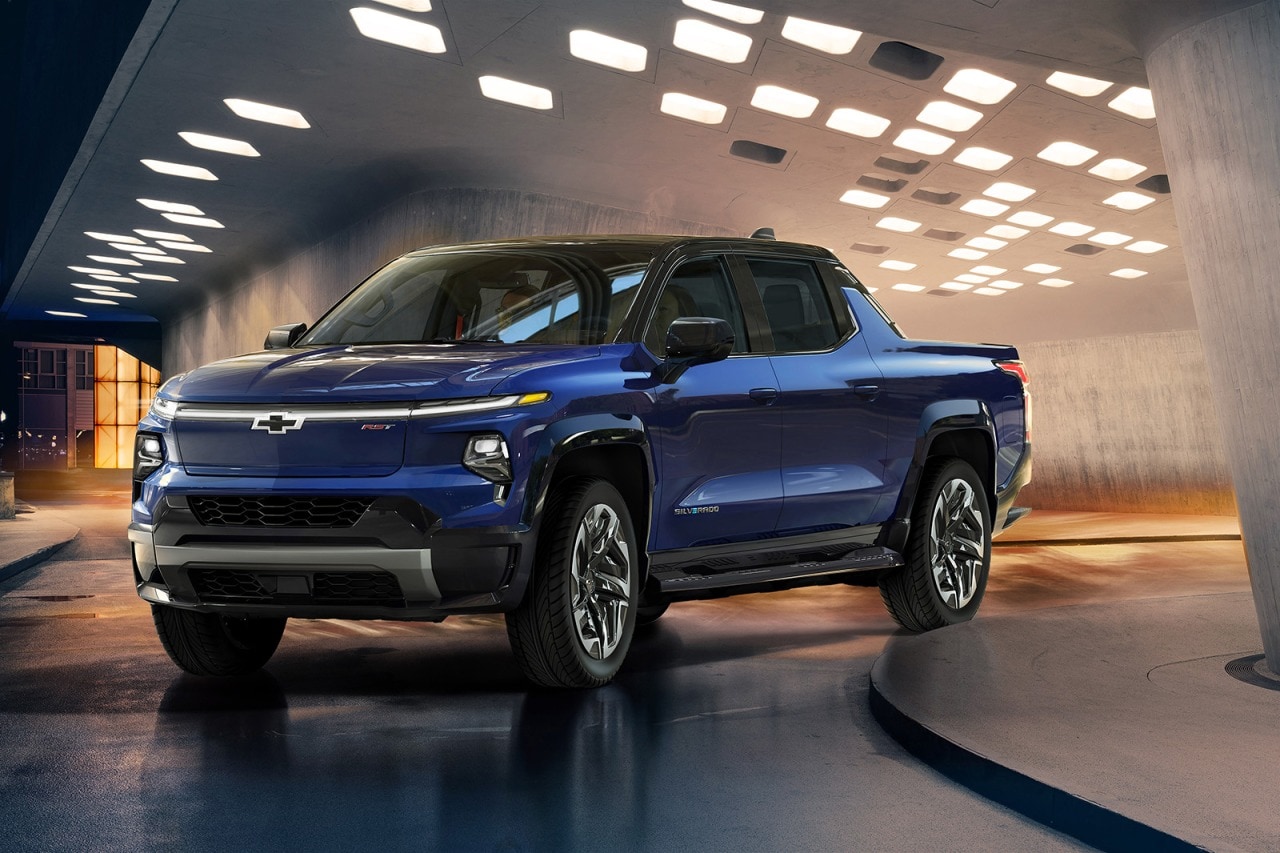- The 2024 Chevrolet Silverado EV is a futuristic Avalanche redux.
- On paper, the Silverado EV specs look promising ... and appealing.
- Ford risks losing some F-150 Lightning reservation holders to Chevy.
Ford F-150 Lightning vs. Chevy Silverado EV Specs Comparison
The new 2024 Chevrolet Silverado EV is looking good in more ways than one
Chevy vs. Ford is a rivalry that spans the automotive age. Now, as the dawn definitively rises on the electric vehicle era, Friday night bragging rights will revolve around vehicles like the Chevrolet Silverado EV and Ford F-150 Lightning. These new electric pickup trucks will become the talk in any town, as they appeal to a wide range of shoppers, whether they live in Berkeley or Texarkana. And now that General Motors has finally divulged some 2024 Chevy Silverado EV specifications, we can perform a quick on-paper comparison between it and its primary rival (for now).
"Avalanche" would've been a better name
Chevrolet surprised us with the Silverado EV's configuration. Rather than employ a traditional separate cab and bed similar to the F-150 Lightning, the Silverado EV uses an integrated body architecture with a removable window and wall separating the cab from the bed. Does that remind you of something? The Chevy Avalanche of old, perhaps? The concept is essentially the same, both to the advantage and detriment of the Silverado EV.
In any case, while the Ford F-150 Lightning looks like the standard F-150, the new Silverado EV looks nothing like today's Silverado. That is a good thing. A really good thing. In fact, the Silverado EV is handsome enough to draw our eyes away from the Rivian R1T.
Chevrolet also appears to finally have gotten the memo about cheap truck interiors. The Silverado EV has nothing of the sort — at least in the introductory RST First Edition specification, which is all kinds of fancy inside. The technology is terrific, too, from the digital instrumentation to the 17-inch touchscreen infotainment system mounted in desirable landscape orientation. Comparatively speaking, the F-150 Lightning's cabin resembles the standard F-150's but with a vertically oriented 15.5-inch screen that looks like an iPad glued to the middle of the dashboard.
Even when you dress up the F-150 Lightning in Platinum trim, it just doesn't come close to looking as cool as the blandly named Silverado EV. "Lightning" is a great name. Chevy really should've revived the Avalanche nameplate to give this electric truck a little pizzazz.
Which one is better for work?
Am I Ready for an EV?
- EV ownership works best if you can charge at home (240V outlet) This typically means a 240V home installation, or other places your car is parked for several hours each day. Don't expect a regular household outlet (120V) to suffice.
- Adding a home charging system is estimated to cost $1,616 in This is an estimate for your area. Using your address and the answers you provide, Treehouse can provide a more accurate price.
- Edmunds is partnering with Treehouse, an independent provider of home EV installation services. Learn more Edmunds customers receive a 10% installation discount and 4% smart charger discount. Discount excludes permit, hosted inspection, and load management devices. Valid for 30 days.
Both of these trucks are launching first to commercial customers. On paper, between the Silverado EV Work Truck (which will cost $39,900 without destination charges) and the F-150 Lightning Pro ($39,974 without $1,695 in destination charges), the Ford appears to be the better electric truck for commercial use.
Why? It offers more power and torque and a higher payload rating, of 2,000 pounds versus the Silverado EV WT's 1,200 pounds and RST's 1,300 pounds. Plus, the Lightning has a tailgate with helpful measurements stamped into it for when you're on the job site and offers an interior work surface that turns the center console into a laptop station. Innovative technology features such as Onboard Scales, Smart Hitch and Pro Trailer Hitch Assist are genuinely helpful to people who work their trucks. Plus, at 10,000 pounds, the Lightning will initially have more towing capacity than the Silverado EV WT's 8,000 pounds, though the Silverado RST can pull 10,000 pounds. Chevrolet also says it is working on a Max Tow version of the Silverado EV work truck that can trailer up to 20,000 pounds — double what the Ford can tow. Stay tuned.
With its separate cargo bed, you can dump stuff into the Ford without worry. Get careless with the Chevy, and it seems to us you could damage the Multi-Flex Midgate that separates the cab from the bed. The F-150 Lightning's 14.1-cubic-foot front trunk (frunk) with 2.4-kW of exportable power also strikes us as larger and more useful. The Silverado EV has a frunk too, but Chevy didn't brag about its size or power outlets, so there might not be a story there.
The Chevy could trump the Ford in maximum driving range on a full battery. The Silverado EV Work Truck will travel an estimated 400 miles between visits to the charging station, while the F-150 Lightning Pro needs a hookup at the 300-mile mark. The Chevy is also compatible with 350-kW DC fast chargers, while the Ford can draw a maximum of 150 kW. That means the Chevy gets back to work sooner.
Which one is better for play?
Choosing between the Chevrolet Silverado EV and Ford F-150 Lightning for personal use is easier. On looks alone, the Silverado EV will attract customers. But the truck's estimated 400-mile driving range, Multi-Flex Midgate, Multi-Flex Tailgate and sophisticated interior technology will make it irresistible to personal-use buyers.
Granted, the Chevy's payload rating is substantially lower than the Ford's. But the fact that you can fold part of the back seat, remove part of the rear cab wall, and carry a sea kayak and a rear-seat passenger simultaneously is impressive. According to Chevrolet, the Multi-Flex Midgate expands the Silverado EV's bed from just under 6 feet to just over 9 feet in length. Meanwhile, the Ford's 5.5-foot bed is fixed. Dropping the tailgate of either truck adds some load-floor length, with the Chevy's maximum amounting to nearly 11 feet!
Chevrolet says the Silverado EV RST First Edition will cost a whopping $105,900, plus destination. That's a little nutty. But when Ford is charging a super-specific $90,874 plus destination for the F-150 Lightning Platinum, what's another 15 grand for something that is definitively different?
Ford is also delivering trucks in a matter of months, while the Silverado WT is a year away and the high-end, consumer-focused RTS isn't due until the end of 2023. An expanded Silverado EV lineup will come later in 2024.
Edmunds says
Unfortunately for Ford, delays in getting the F-150 Lightning into customers' hands may squander its first-mover advantage. Now that we know more about the new 2024 Chevrolet Silverado EV, we would not be surprised to see some of Ford's reservation holders cancel their deposits and switch to the Chevy.
But Ford is planning to deliver trucks in a matter of months, while the Chevy isn't due until next spring in Work Truck spec, with the RST, Trail Boss and other variants coming starting in late 2023. That would give F-150 Lightning owners at least a year of uncontested bragging rights on Friday nights.
Specification | Chevrolet Silverado EV | Ford F-150 Lightning |
|---|---|---|
| Maximum driving range | 400 miles (est) | 300 miles (est) |
| DC fast-charging compatibility | 350 kW (100 miles in 10 minutes) | 150 kW (54 miles in 10 minutes) |
| Maximum horsepower and torque | 664 hp and 780 lb-ft | 563 hp and 775 lb-ft |
| Maximum towing capacity | 10,000 lbs (RST) | 10,000 lbs |
| Maximum payload capacity | 1,300 lbs (RST) | 2,000 lbs |
| Maximum bed length (tailgate up) | 9 ft (est) | 5 ft 6 in |
| Maximum exportable power | 10.2 kW | 9.6 kW |
| Frunk size | TBD (looks smaller) | 14.1 cu ft |
| Wheel size | 24 in (max) | 22 in (max) |
| Infotainment screen size | 17 in, landscape orientation | 15.5 in, portrait orientation |
| Hands-free driving system | Super Cruise on over 200,000 miles of roads | BlueCruise on over 130,000 miles of roads |
| Base price | $39,900 (not including destination) | $39,974 (not including destination) |






 by
by